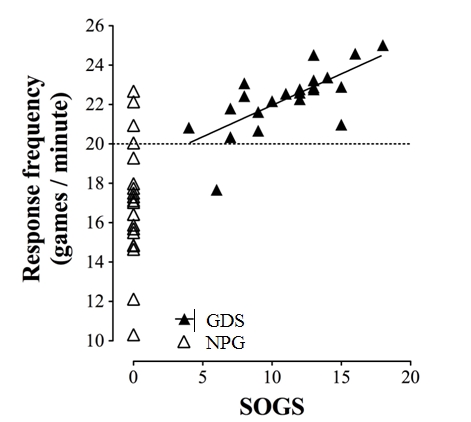The WAGER, Vol. 18(10) – Slot machine response frequency predicts gambling disorder
Some structural characteristics of slot machines are believed to increase the time and money gamblers spend gambling. These characteristics might include frequent small gains and “near misses”, big wins, and manipulation of symbol sequence and contingencies (as reviewed by Linnet, Thomsen, Møller, & Callesen, 2013). In addition, differences in how people play slot machines might differentiate people who have gambling problems from those who do not. This week’s WAGER reviews the first study to demonstrate an association between the frequency of slot machine responses and Gambling Disorder (GD) (Linnet et al., 2013).
Methods
- Researchers assessed the slot machine response frequency (i.e., the number of button presses per minute) of 22 people with gambling disorder (GDs) and 21 non-problem gamblers (NPG), identified as such by the South Oaks Gambling Screen (SOGS) (Lesieur & Blume, 1993; Lesieur & Blume, 1987), as they played a commercially available machine, “The Oriental Express.”
- Researchers recruited participants via local newspaper advertisements.
- The participants did not play with their own money and could not lose money, but could keep a small portion of their winnings.
Results
- GDs played the slot machine more rapidly (M = 22.32 button presses per minute, SD = 1.60) than NPGs, M = 16.98, SD = 3.00.
- The researchers could use response frequency to predict who had gambling problems and who did not: response frequency provided accurate classifications for 21 out of 22 (95.5%) GDs and 18 out of 21 (85.7%) NPGs.
- As symptom severity increased, so did response frequency, r (22) = 0.71). The results are illustrated in Figure.

Figure. Scatterplot showing association between response frequency and SOGS scores among GDs (black triangles) and NPGs (white triangles). Click image to enlarge.
Limitations
- GDs were generally older than NPGs, and though the correlation remained significant after controlling for participant age, the findings should be replicated in an age-matched cohort.
- The SOGS is screen for gambling disorder, and formal clinical assessment would increase confidence in the diagnostic categories.
- It is not possible from the data to determine the stability of response frequencies; in other words, do participants with gambling disorders experience high response frequency every time they played, or just sometimes?
Conclusions
Response frequency is a simple and easy measure suitable for assessment of risky behavior in real-time slot machine gambling. Unlike time spent gambling, number of gambles, and money spent gambling, response frequency can be observed over a matter of minutes, by simply counting the average response frequency over a short period of time. Furthermore, response frequency might have implications for other forms of gambling than slot machine gambling. Response frequency of games such as black jack, roulette, or craps could be measured as the time it takes to make a decision or response, rather than games per minute, as the game frequency in these games are determined by a dealer. However, more research is needed to determine the usefulness of response frequency in relation to assessment of gambling disorder, and whether it can be used as a tool to predict the development and best treatment of gambling disorder.
-Jacob Linnet
What do you think? Please use the comment link below to provide feedback on this article.
References
Lesieur, H., & Blume, S. B. (1993). Revising the South Oaks Gambling Screen in different settings. Journal of Gambling Studies, 9, 213-223. doi: 10.1007/BF01015919
Lesieur, H. R., & Blume, S. B. (1987). The South Oaks Gambling Screen (SOGS): A new instrument for the identification of pathological gamblers. American Journal of Psychiatry, 144(9), 1184-1188.
Linnet, J., Thomsen, K. R., Møller, A., & Callesen, M. B. (2013). Slot Machine Response Frequency Predicts Pathological Gambling. International Journal of Psychological Studies, 5(1), 121-127.